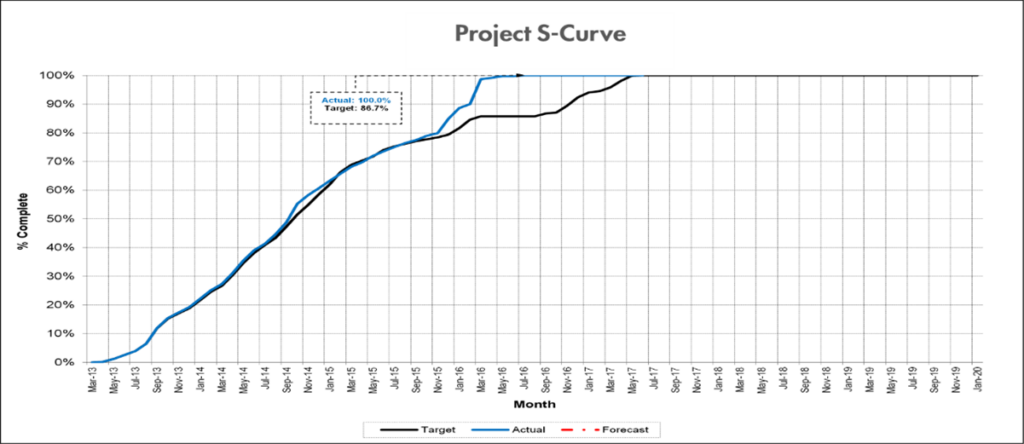
By Areje Adegoke – Opportunity Development Lead (Bonga Main and Bonga North) Shell Exploration & Production Company of Nigeria Limited (SNEPCo)
Project management is important for any project — from the very small personal ones like planning a family gathering, to very large capital projects like Oil and Gas development. You go through the same steps such as defining the goal or an outcome you want to achieve, and the pathways you are going to take to reach the desired outcome. However, when talking about a business project, you need to identify the project team in place, determine if you need to hire contractors, and if so, determine who will get the contract, and then award the contract. Additionally, one needs to ensure risks are mitigated as the effectiveness of risk management can make or break a project. Finally, timelines are estimated, a budget is drawn up and then the project is executed.
The project management framework is critical because, like a frame that holds up a building, it ensures all aspects of the project fit together, and that the project will be delivered within the defined budget and schedule. The project management framework needs to break the project into small tasks or controls that are easily managed. It should help with the allocation of time and resources and include components of risk management, and quality control. Clear communication and project tracking are also key elements of managing a project. When a framework is properly designed, the project leaders and other team members should be able to communicate effectively and deliver consistent and regular information and updates. And while there are a number of good project management framework tools available to choose from to help the project manager deliver on the stated goals, many capital projects still fail to meet their objectives.
What are the causes of Capital project management framework failures and setbacks?
- One of the reasons projects fail is their complexity. As complexity increases, there is a tendency to increase the number of mandatory controls in the project management framework. From my experience, when gaps are identified during the execution of projects, we seek to fill the gaps by creating more information. This translates to more controls being created which may not necessarily contribute to achieving the project outcome. This continuous cycle has generated a large volume of materials within our projects today, that stems from the attempt to control things outside of our control
- Controls may be too prescriptive – When controls are highly prescriptive, it leads to a dilution of accountability. There is often a misalignment between the prescriptive approach and the proactive behaviours expected from the project team members. The team should think in terms of project outcomes and the risks associated with achieving them while challenging activities that are not adding value to the bottom line. For example, where more than one projects are being executed within the same area at the same time, preparing an integrated decision-based roadmap becomes helpful in identifying execution synergies that can save cost and time. Conversely, a project where external stakeholders have little or no influence on decisions, a Stakeholder Engagement Plan may not be required, or a scaled down version would suffice. In some cases, some documentation (e.g., Health, Safety and Security plan, Stakeholder Engagement Plan, Risk Management Plan etc.) can be prepared for a cluster of projects or handled at a corporate level such that each project only needs to reference them without duplicating effort. Highly prescriptive controls do not leave room for innovation.
- Poor Communication and Integration – To get the desired outcome, project team members need to work together like a well-oiled machine, where each component plays its role seamlessly and delivers to the next component. When different project functions work in silos, there is often misalignment. Again, this can have significant impact on budget and schedule. This often happens when there is poor communication amongst the project leaders, between the leaders and the teams, and within the team
Focus on Project Outcomes to Fix the Problem
Sometimes the solution to improving project management is not additional controls and measures. It is rather simplification. Moving away from an activity-based approach to a risk-based, outcome-focused approach. This approach focuses on key risks and controls that have significant impact on the project outcome. It reduces the level of task prescription and empowers competent team members to be creative and come up with innovative ideas that add value. In addition to improving the manageability of a project, simplicity in the project management methodology makes replication easier. When a process is easy to replicate, it enables stability.

For this to work, the project leaders need to have a shared understanding of the desired outcome, risks, and decisions required. They must work collaboratively to make project specific activities, following an integrated thought process. This is where integration begins. The outcome is better quality decisions. With a well-defined logical framework for project management, there will be a clear description of the various controls, and the project manager will be required to allot roles and responsibilities to every team member. This brings clarity and eliminates confusion.
Below is an example where this process was followed- streamlining the project controls and deliverables to focus on the desired outcome. The project was completed 10 months ahead of the planned schedule. The main contributors to this success were:
- Diligent risk management
- Intent based project integration and assurance
- Excellent leadership – driving the right behaviours

What does a good outcome statement look like?
A good outcome statement helps you identify risks, make decisions and plan activities to meet the desired outcome. It can also provide the strategic context for cascading intent to your team. The elements that make up a good outcome are:
- The Purpose – This is the reason why the outcome is desired
- Method – Indicate how the team would progress towards the end state. This is the actionable part of the why
- End State – The expected result
Intent of Controls
The intent of a control is what we want to achieve with the control, such as managing a risk towards an outcome. Controls need to be directly aligned with the risks. They should effectively manage key delivery risks and drive behaviors. Assurance and monitoring of controls are required to ensure the controls are being complied with. The success of the project is defined by the quality of the outcomes not by the activities that have been completed or deliverables produced.
A control should have at a minimum, context, activity, purpose, evidence location (where the evidence is stored), and the person accountable for meeting the control intent.
Why is Intent important?
The reason for cascading intent rather than just the controls is to empower teams and guide their initiative and improvisation such that they can challenge the activities in line with the specific project and adapt if/when conditions change. It makes collaboration more effective and efficient. The project manager communicates instructions as an intent, this becomes the guideline for the team member. The intent should contain the context or purpose and execution constraints. Effective communication is key here. The project manager should confirm from the team that the intent is clearly understood.
Conclusion
Simplifying the Project Management Framework in line with project outcomes and risk management will help you focus more on what really matters. It will inspire the project team to think and act differently because they are empowered and given more freedom of action within clear boundaries. The advantage of this is that authority is moved to where the information sits – within the team. This simplification also drives more effective collaboration and enables repeatability and stability.
For more information, please contact Hedy Baker, [email protected].
Share This:




 CDN NEWS |
CDN NEWS |  US NEWS
US NEWS 

























COMMENTARY: Fossil Fuels Show Staying Power as EU Clean Energy Output Dips – Maguire